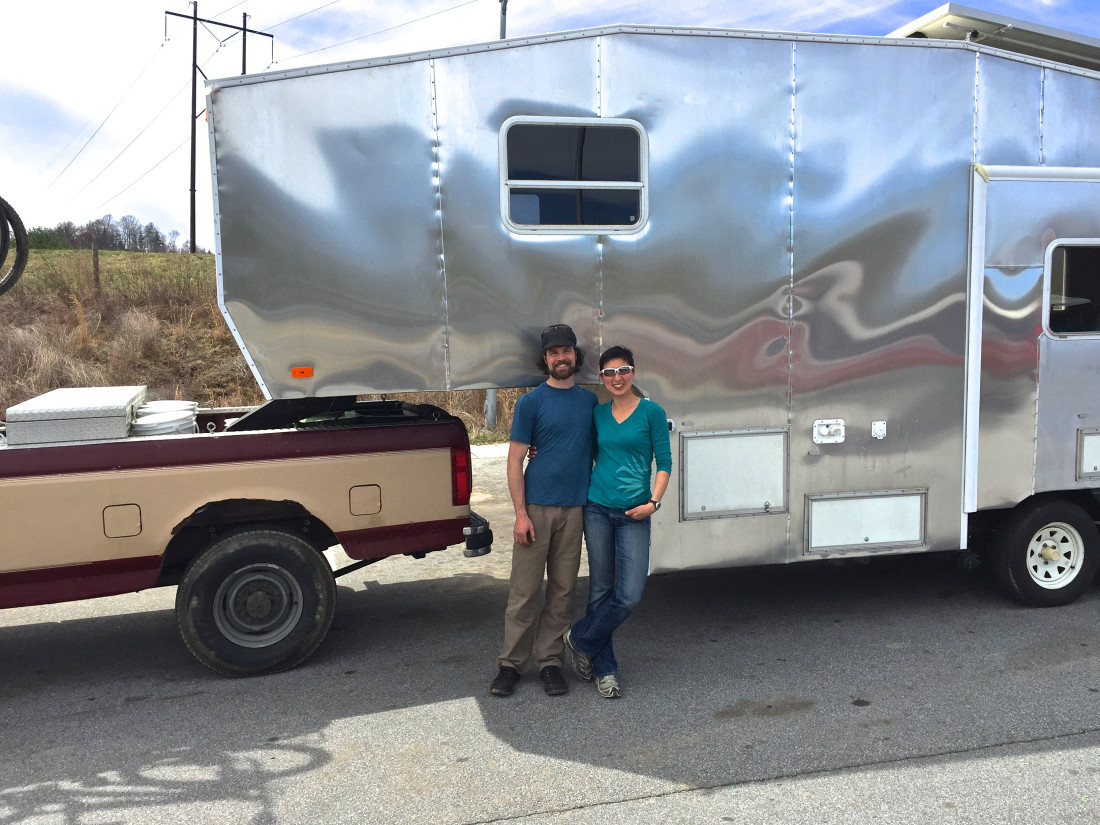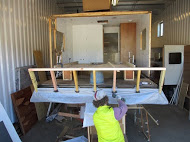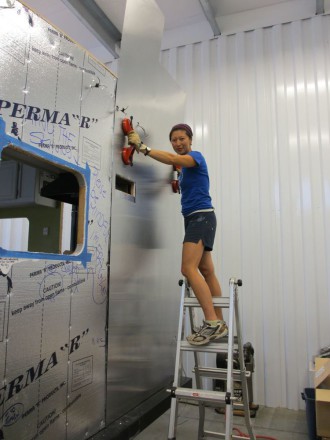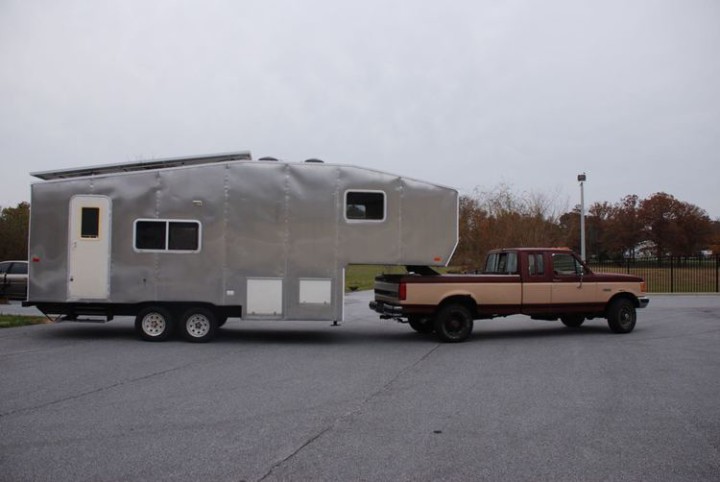We all have dreams that we talk about over and over, whether to ourselves, our friends or our significant other. A lot of times, those dreams end with the words “someday” or “soon.” That’s how it was for Jerud and me. Our relationship was fairly new, and we talked about what we wanted out of our lives. It wasn’t anything unique: We wanted to explore, to travel and to spend time in nature. Traveling overseas was out of question for me because of Tybee, a loving Lab/Rott; I’d spent six months in Kenya years ago when Tybee was younger, and I missed the crap out of her. Sure, she’s a dog, but if you’re a dog person, you’ll understand. Going overseas is more exciting and exotic, but we agreed that there’s just as much to see in the U.S.
We tossed around various ideas about how we could travel extensively and long term with our now two dogs plus all of our outdoor gear. The simplest way would be to live out of a truck — except that we can’t leave Tybee and Tyki (a spunky blue heeler mix) in the truck while we go on daylong mountain bike rides in the summer or snowboarding in winter. Tybee’s getting older, and she’s a lot more limited in what she can do, so she has to be safe and comfortable while we’re out and about. The answer turned out to be moving into an RV.
Initially, we were skeptical because of the large carbon footprint — poor gas mileage, plus the need for propane when not plugged into the grid. Besides, the prospect of staying in crowded RV parks and spending so much time inside the vehicle wasn’t all that appealing. And anyway, we couldn’t afford to live a traditional RV lifestyle for long, due to the high costs involved.
For all those reasons, we nearly rejected the idea entirely — until we realized we could modify the RV to better match our priorities.
Off-gridable
With our love for the outdoors comes a sense of responsibility for taking care of it, and one of the biggest downsides of traveling in an RV is its fossil fuel usage. We couldn’t justify driving around the country burning diesel fuel at 10 mpg. So we decided that the truck that towed our RV would have to be converted to burn waste vegetable oil obtained from restaurants. And since most RVs rely on grid electricity and propane, which are also created from fossil fuels, we knew our trailer would have to be solar-powered.
Another consideration was fresh water consumption. To reduce it, we replaced the traditional toilet with an Air Head composting toilet. Thanks to these modifications, I describe our setup as “off-gridable”; I don’t consider it “off-grid” in the truest sense. We’re not collecting our own water, and we’re still using public sewer systems to dump the wastewater from our sink and shower. In addition, our oven/stove runs on propane. It’s only a tiny amount, since it’s powered by a camping fuel bottle, but we weren’t sure we could satisfactorily replace it with an electric alternative. We’re still looking for ways to eliminate this use of fossil fuel.
In 2011, Jerud and I found ourselves standing in Tom Johnson’s lot in Marion, looking at used RVs with our friend Barbara. We were there just to browse; she was there to share her knowledge and experience (Barbara and her partner, Mary, had started living in their RV full time the year before). But a month later, the Tom Johnson sales associate called us to say she’d found a used RV that met our specifications and price range, though the roof had some water damage. We knew we weren’t ready to leave Asheville yet, but it was too good a deal to pass up.
Living in the Toaster
It wasn’t until December 2013 that we committed to renovating the RV. In the interim, we traveled some and enjoy life in Asheville. But the fear of time slipping away, leaving the RV as just an oversized reminder of a failed dream, had grown stronger, fueling an increased sense of urgency to finally buckle down and get it done. I was terrified that, before we knew it, 10 years would have elapsed and we would still be talking about “living on the road.”
Meanwhile, we’d also realized that waiting for all our ducks to line up perfectly meant exactly that — waiting. Eventually we just had to take the plunge. Needing a dry space to repair the roof repairs, we rented an indoor storage unit in Arden. For the next year, our lives consisted of going to work and fixing up the RV after work and on weekends.
Early on, we got a huge unwelcome surprise. Our short to-do list consisted of replacing the roof, painting the interior and making some eco-friendly upgrades. But when we took the roof apart, we uncovered much more water damage than we’d expected. The “renovation” turned into a rebuild, and what we thought would take three months wound up taking a year.
We took everything out of the RV, tearing it down to the studs and even ripping out part of the subfloor. And though we cursed our bad luck, in fact it worked out for the better, because we were able to make additional changes while the vehicle was torn apart. We still spent less than we would have if we’d bought a new one, and now that we’re living on the road, our expenses are less than they’d be with an off-the-lot RV.
Life in our 200-square-foot home, which we’ve nicknamed the Toaster because of its new look, hasn’t been as hard as we’d imagined. Even when we were living in our 1,200-square-foot house in Asheville, we realized that we mainly used only a couple of rooms. Besides, we don’t actually spend that much time in the Toaster: We’re outside in the woods hiking and biking, or in town with its extensive Wi-Fi connections.
We do occasionally step on each other’s toes, literally and figuratively, but over time, we’ve learned how to keep those collisions to a minimum. Basic rules include only one person in the kitchen at a time; don’t make piles; clean up messes and wash dishes immediately.
An off-gridable life is a conscious life: We’re a lot more aware of how much water and electricity we use daily. For example, we can run the space heater and electric tea kettle at the same time, but if the refrigerator kicks on, it will overload the inverter and trip the breaker.
When the weather gets down into the 30s or below, we plug up the windows and ceiling vents with Reflectix (which is like a car-windshield sunshade) to help keep the Toaster toasty inside. And since the bedroom has extra insulation, we’ll barricade ourselves in there with the dogs at bedtime and run the electric heater overnight. During our time in Colorado, we’ve woken up to snow a few mornings. The first thing we do is clear the snow off the solar panels so they can start absorbing sunlight as soon as the sun comes out.
Our composting toilet has required more of an adjustment. Overall it’s easy to use, but there are things we had to get used to. The toilet has two tanks, one for liquid and one for solids. The liquid tank has to be emptied a lot more often; on our first outing, we didn’t keep track of how full it was and overfilled it! Each day, we’re learning how to live better with the Toaster.
A growing trend
Living on the road in RVs and tiny homes is becoming more popular. RVs are no longer just for retirees: More and more people are realizing that they’re not interested in traditional lifestyles and priorities. Folks of all ages, backgrounds and interests — whether they’re individuals, couples, friends or families with kids and pets — are hitting the road in one form or another.
In that respect, what we’re doing isn’t anything new or special. Nor is our desire for a sustainable lifestyle. What makes us different is that we do both of these things simultaneously: Our RV is powered by solar panels, and our truck runs off waste vegetable oil. Our goal to live small and ride free has been achieved in many ways.
Our Asheville friends have been really supportive. Some came and helped us during the renovations and when we moved out of our house. And while some of them didn’t believe our lifestyle change would ever really happen, I can’t say I blame them, considering how long we talked about our plans before actually doing anything. But when we were finally ready to hit the road, everyone was excited — and maybe even shocked.
When they lived in Asheville, Ching Fu was REI’s community outreach coordinator; Jerud Crandall was a design engineer at BorgWarner. You can follow their travel adventures at LiveSmallRideFree.com.










This is really great info. I wanted to live in an RV full time for many years before finally taking the plunge. Believe me, it’s never too late to live your dream! Just don’t lose faith and know that it will be worth it in the end, despite all the hard work. I was lucky to find some great advice that helped me find the right rv and keep things under budget. Here is one of the resources that helped me a lot: http://rvlivingcorner.com/optin-comments.html
Breaks of rooftop are the most critical disappointing issue in nastiness and may be illuminating with EPDM Rubber
Roof Repair with flawlessness, life span and solidness.